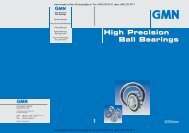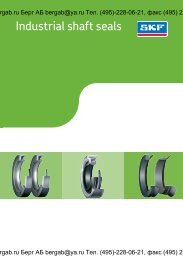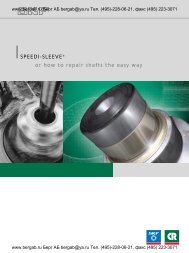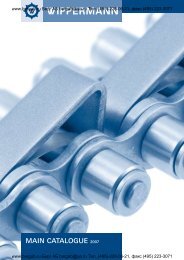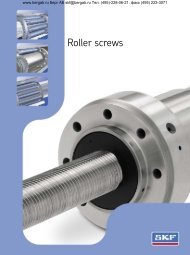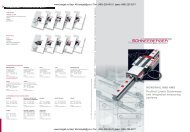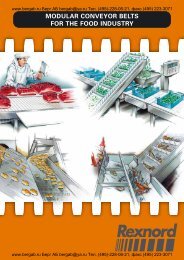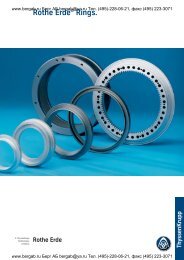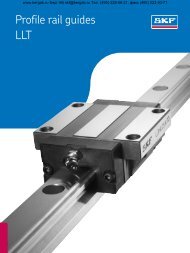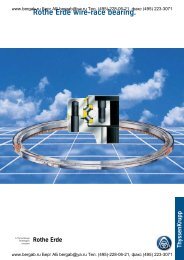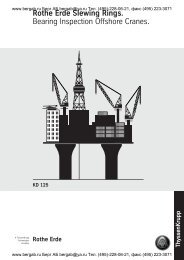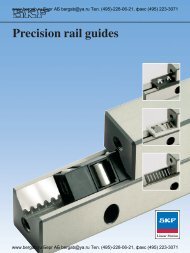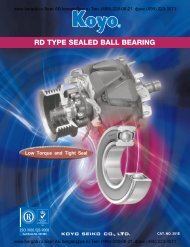Chains
Chains
Chains
Create successful ePaper yourself
Turn your PDF publications into a flip-book with our unique Google optimized e-Paper software.
Product<br />
Handling<br />
www.bergab.ru Берг АБ bergab@ya.ru Тел. (495)-228-06-21, факс (495) 223-3071<br />
In many countries regulations dictate a certain absolute sound level at a workplace. In industrial buildings like breweries where glass is involved, the<br />
noise level could be very high at some places. In general there are three areas where something can be done to reduce the noise level : Machines,<br />
conveyors and the building itself.<br />
The highest noise levels on conveyors are the result of unfavourable product handling. Collision of bottles against each other or against guiderails<br />
produces noise. Increasingly high speeds of bottling lines result in an increase of the noise level, due to the higher collision speed.<br />
Several measures can be taken to reduce the noise level of products.<br />
1) Use curves instead of deadplate transfer. A Dynamic Transfer System (refer to our MatTop® catalogue) is much better than a dead plate transfer,<br />
also in terms of noise. However, a curve is the optimum solution.<br />
2) Bottles should be handled with care. On zero-pressure combiners, bottles will smoothly move into one row, producing a low noise level. Careful<br />
handling is also in the interest of less scuffing and less bottle breakage.<br />
3) Good flow control possibilities, which can be obtained by building conveyors with a certain maximum length. The chainspeed can be controlled by<br />
using PLC's and frequency controlled drives. When for instance one conveyor runs full, the chainspeed on the preceding conveyor can be<br />
decreased.<br />
4) Cover guiderails and other components with plastic profiles. In general, plastic materials can result in a decrease of the noise level, compared to<br />
metal in contact with glass.<br />
5) Use plastic sprockets and idlers.<br />
Reducing noise<br />
6) Use plastic wearstrips in combination with stainless steel chains.<br />
7) When the return part is executed with return rollers, it is recommended to use rollers with a<br />
large diameter of +/– 60 mm. The use of small rollers could result in a rattling sound. Rollers<br />
with a rubber surface are available. They will contribute to a lower noise level.<br />
8) Plastic chains running dry in curves can sometimes produce noise. In this respect Magnetic<br />
System is better than Tab curves. If the cause of the noise cannot be located, consider<br />
lubrication.<br />
Selective<br />
lubrication<br />
Selective<br />
lubrication<br />
Maximum temperatures<br />
It is important to check the materials regarding the allowable temperatures. In the Rex catalogue and calculation program, product specifications are<br />
based on a temperature of 21°C. When the environmental temperature differs significantly, this will influence the mechanical properties and thermal<br />
expansion of chains. This is especially important on plastic products.<br />
In the table below the minimum and maximum temperatures are given for materials. A continuous exceeding of these temperatures can result in product<br />
failure.<br />
Allowable temperature<br />
Chain material and type<br />
T min (°C) T max (°C)<br />
Stainless steel chains<br />
Hardened steel chains<br />
Stainless steel rubber top chains<br />
Acetal plastic chains, dry<br />
Acetal plastic chains, wet<br />
Table 10- Allowable temperatures<br />
-70<br />
-40<br />
-35<br />
-40<br />
-40<br />
Thermal expansion<br />
430<br />
180<br />
100<br />
80<br />
65<br />
Please be aware that plastic chains and belts expand or contract more<br />
than metal parts due to temperature changes.<br />
The coefficient of thermal expansioin of the plastics are:<br />
Material<br />
Acetal LF, HP<br />
AS- material<br />
WPP- material<br />
Coefficient of thermal expansion<br />
0.12 mm/m/°C<br />
0.13 mm/m/°C<br />
0.15 mm/m/°C<br />
Table 11- Coefficient of thermal expansion<br />
www.bergab.ru Берг АБ bergab@ya.ru Тел. 113 (495)-228-06-21, факс (495) 223-3071



